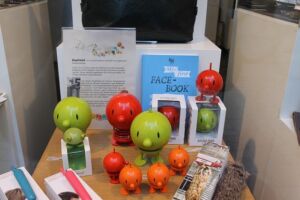Business & Education
Springing back from the scrapheap: the eternal hoptimist
This article is more than 9 years old.
It all began in the 1960s, when a Danish cabinet maker made his biggest breakthrough with the simplest of plastic toys

While Danish design has long had a reputation as being ’functional’, sometimes its greatest designs serve no real purpose at all, other than putting a smile on one’s face on a cold January day like today. One of its classic creations, Ehrenreich’s ‘Hoptimist’, was one such design.
The playful, plastic Hoptimist figures are round, simple shapes that are attached to a spring and simply quiver with energy. The springy mobiles were the latest craze back in the early 1970s, with amusing characters like ‘Busy Birdie’, along with later additions Bimble, Bumble and the two frogs, Kvak and Baby Kvak.
Never still in Stilling
The father of all Hoptimists was Hans Gustav Ehrenreich (1917-1984), a designer from the small town of Kolind in Jutland. After moving to Stilling near Skanderborg in 1943, he set up his own business as a cabinet maker, working with a number of rare and exotic woods. Ehrenreich’s international breakthrough came at an arts and crafts exhibition in Chicago in the 1950s, and by the mid-1960s he was established as a successful craftsman.
But it was not wood, but plastic that was to be the raw material for Ehrenreich’s classic invention: a small, springy, brightly-coloured mobile he made in 1968 and dubbed ‘the Hoptimist’. Bright, primary colours were the fashion of the times, and the figure, with its large head and small feet, was drawn using only a circle and an ellipse, and then cast from the same plastic as another Danish design classic, Lego bricks.
By 1971, Ehrenreich’s Busy Birdie was being sold all over the world from his small factory in Stilling. On the box was a poem that began: “There are other birds who use beaks and claws, but I prefer to chirrup with just as light a humour.”
Infectiously playful
Within a year or two, Birdie was joined by a couple, perhaps married, whose imagined banter found its way into a marketing cartoon. Bimble (the female of the two) and Bumble (the man) were just as springy and infectiously playful as the first Hoptimist.
The last members of Ehrenreich’s Hoptimist family were Kvak and little Baby Kvak, two jumping green frogs.
Production stopped on the Hoptimists in 1974, and with Ehrenreich’s death in 1984 it seemed as if the bouncing figures had been relegated permanently to the attic as another amusing, but forgotten diversion of the ‘60s and ‘70s.
A 21st century revival
In 2009, however, designer Lotte Steffensen, whose resume includes fashion design at Danish fashion houses Bitte Kai Rand and Red/Green, relaunched the Hoptimist brand in consultation with Hans Gustav’s son, Jørn Ehrenreich.
Steffensen sees the Hoptimists as part of an extended Danish design family that also includes Poul Henningsen’s iconic PH lamps and Kay Bojesen’s wooden monkey. And while they may not appear to serve any clear function, she is convinced that the Hoptimists are as irresistible to adults as they are to children.
An ambassador of happiness
Steffensen viewed Hoptimists as little mascots that spread joy wherever they’re placed. “They’re all about smiles and a surplus of energy,” read the relaunched Hoptimist website. “We are in no doubt at all about why we’ve thrown ourselves into producing Hoptimists. It’s because there’s something about Hoptimists. They make people smile, inspire life and give people the urge to do something.”
Two newcomers to the Hoptimist family, the clowns Bibi and Bobo, were made the official ‘Danish Hospitals Caring Clowns’, representing an association that helps sick children across the country with humour and therapeutic care.
With Denmark’s reputation as one of the happiest nations in the world, shouldn’t it also have an ambassador that reflects that kind of happiness?










































